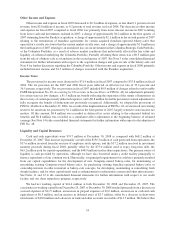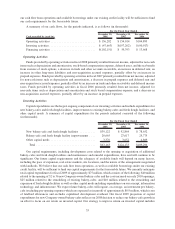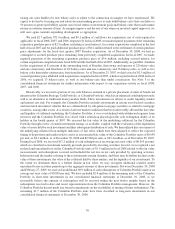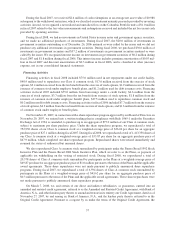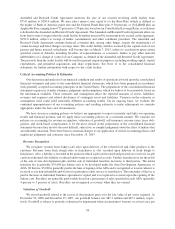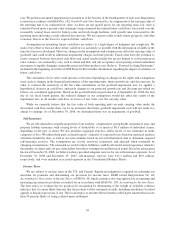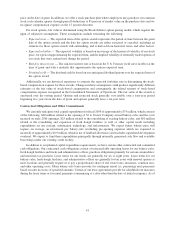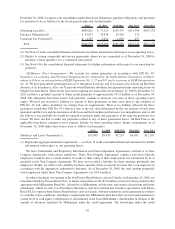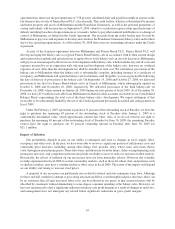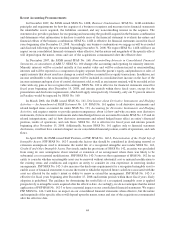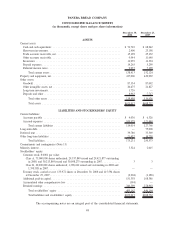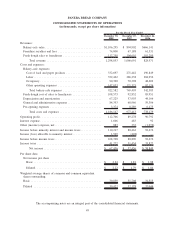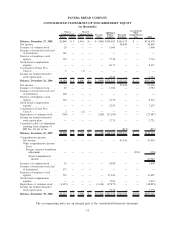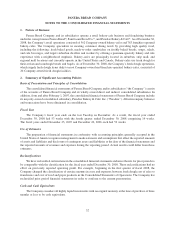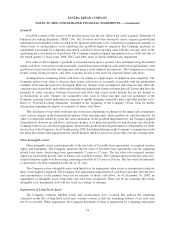Panera Bread 2008 Annual Report Download - page 51
Download and view the complete annual report
Please find page 51 of the 2008 Panera Bread annual report below. You can navigate through the pages in the report by either clicking on the pages listed below, or by using the keyword search tool below to find specific information within the annual report.Recent Accounting Pronouncements
In December 2007, the FASB issued SFAS No. 141R, Business Combinations. SFAS No. 141R establishes
principles and requirements for how the acquirer of a business recognizes and measures in its financial statements
the identifiable assets acquired, the liabilities assumed, and any noncontrolling interest in the acquiree. The
statement also provides guidance for recognizing and measuring the goodwill acquired in the business combination
and determines what information to disclose to enable users of the financial statement to evaluate the nature and
financial effects of the business combination. SFAS No. 141R is effective for financial statements issued for fiscal
years beginning after December 15, 2008. Accordingly, any business combinations we engage in will be recorded
and disclosed following the new standard beginning December 31, 2008. We expect SFAS No. 141R will have an
impact on our consolidated financial statements when effective, but the nature and magnitude of the specific effects
will depend upon the nature, terms and size of the acquisitions consummated after the effective date.
In December 2007, the FASB issued SFAS No. 160, Noncontrolling Interests in Consolidated Financial
Statements, an amendment of ARB 51. SFAS No. 160 changes the accounting and reporting for minority interests.
Minority interests will be recorded initially at fair market value and will be recharacterized as noncontrolling
interests and will be reported as a component of equity separate from the parent’s equity, and purchases or sales of
equity interests that do not result in a change in control will be accounted for as equity transactions. In addition, net
income attributable to the noncontrolling interest will be included in consolidated net income on the face of the
income statement and upon a loss of control, the interest sold, as well as any interest retained, will be recorded at fair
value with any gain or loss recognized in earnings. SFAS No. 160 is effective for financial statements issued for
fiscal years beginning after December 15, 2008, and interim periods within those fiscal years, except for the
presentation and disclosure requirements, which will apply retrospectively. Currently, only our 51 percent interest
in Paradise would be impacted by SFAS No. 160.
In March 2008, the FASB issued SFAS No. 161, Disclosures about Derivative Instruments and Hedging
Activities — An Amendment of FASB Statement No. 133. SFAS No. 161 applies to all derivative instruments and
related hedged items accounted for under SFAS No. 133, Accounting for Derivative Instruments and Hedging
Activities, and requires entities to provide greater transparency about (a) how and why an entity uses derivative
instruments, (b) how derivative instruments and related hedged items are accounted for under SFAS No. 133 and its
related interpretations, and (c) how derivative instruments and related hedged items affect an entity’s financial
position, results of operations, and cash flows. SFAS No. 161 is effective for fiscal years and interim periods
beginning after November 15, 2008. Additionally, because SFAS No. 161 applies only to financial statement
disclosures, it will not have a material impact on our consolidated financial position, results of operations, and cash
flows.
In April 2008, the FASB issued Staff Position, or FSP, SFAS No. 142-3, Determination of the Useful Life of
Intangible Assets. FSP SFAS No. 142-3 amends the factors that should be considered in developing renewal or
extension assumptions used to determine the useful life of a recognized intangible asset under SFAS No. 142,
Goodwill and Other Intangible Assets. Previously, under the provisions of SFAS No. 142, an entity was precluded
from using its own assumptions about renewal or extension of an arrangement where there was likely to be
substantial cost or material modifications. FSP SFAS No. 142-3 removes the requirement of SFAS No. 142 for an
entity to consider whether an intangible asset can be renewed without substantial cost or material modification to
the existing terms and conditions and requires an entity to consider its own experience in renewing similar
arrangements. FSP SFAS No. 142-3 also increases the disclosure requirements for a recognized intangible asset to
enable a user of financial statements to assess the extent to which the expected future cash flows associated with the
asset are affected by the entity’s intent or ability to renew or extend the arrangement. FSP SFAS No. 142-3 is
effective for fiscal years beginning after December 15, 2008 and interim periods within those fiscal years. Early
adoption is prohibited. The guidance for determining the useful life of a recognized intangible asset is applied
prospectively to intangible assets acquired after the effective date. Accordingly, we do not anticipate that the initial
application of FSP SFAS No. 142-3 to have a material impact on our consolidated financial statements. We expect
FSP SFAS No. 142-3 will have an impact on our consolidated financial statements when effective, but the nature
and magnitude of the specific effects will depend upon the nature, terms and size of the acquisitions consummated
after the effective date.
44


